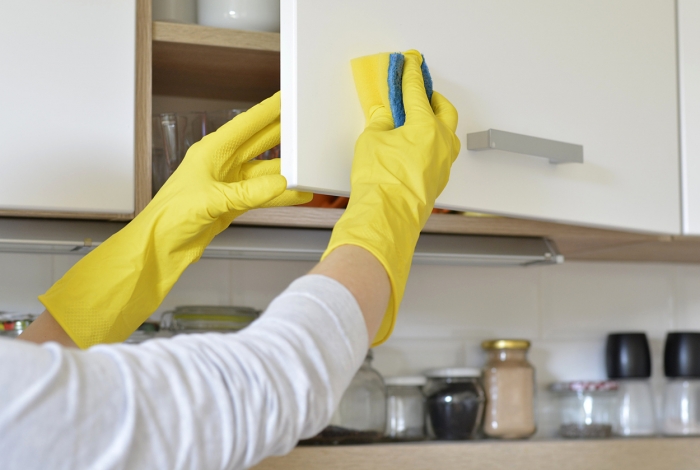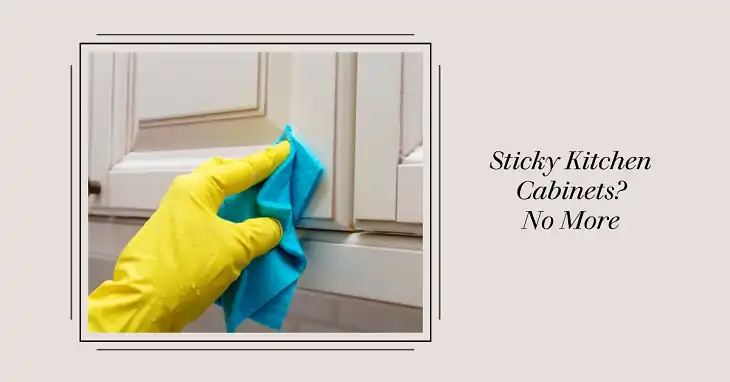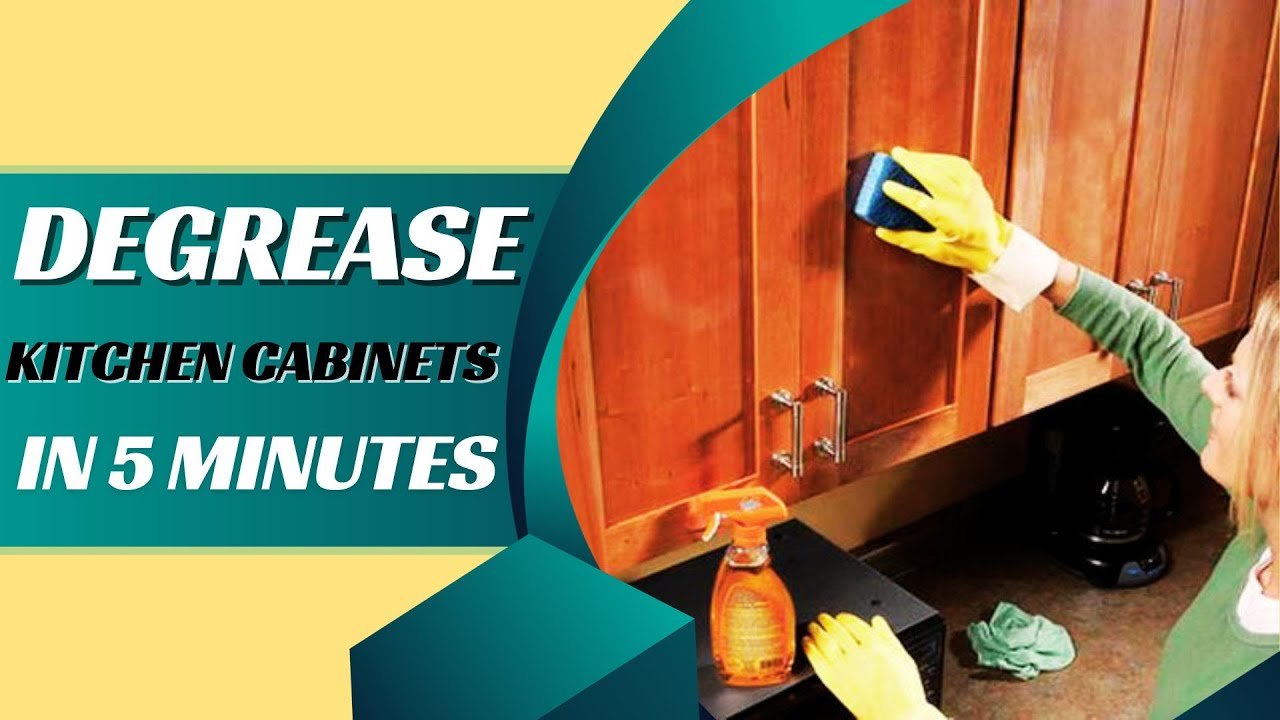Sticky kitchen cabinets after cleaning often result from residue left behind by cleaning products or built-up grease. Inadequate rinsing can also contribute to stickiness.
Sticky kitchen cabinets can be frustrating, especially after you’ve spent time cleaning them. Residue from cleaning products or built-up grease is often the culprit. If not properly rinsed, these substances can leave a sticky film on surfaces. Using too much cleaner or not diluting it correctly can exacerbate the problem.
Consider using a mixture of warm water and mild dish soap for a more effective clean. Rinse thoroughly and dry with a clean cloth to ensure no residue remains. Regular maintenance can prevent the buildup of grease and grime, keeping your cabinets clean and sticky-free.
Table of Contents
ToggleCauses Of Sticky Cabinets
Sticky kitchen cabinets can be frustrating. Understanding the main reasons can help you solve this problem. Here are the key causes of sticky cabinets.
Residue From Cleaners
Some cleaners leave a residue. This residue can make your cabinets sticky. Soap-based cleaners are common culprits. They do not rinse off easily. The leftover soap attracts dirt. This makes the surface feel sticky.
Using too much cleaner can also cause residue. Even water-based cleaners can leave a film. Always follow the instructions on the cleaner’s label.
Grease And Oil Buildup
Grease and oil can build up on kitchen cabinets. Cooking releases grease into the air. This grease settles on surfaces, including your cabinets. Over time, layers of grease can form.
Oils from hands can also contribute. Every time you touch a cabinet, you transfer a bit of oil. This oil attracts dust and dirt. Combined, they create a sticky mess.
Regular cleaning can help. Use a grease-cutting cleaner to tackle this issue. Ensure the cleaner is safe for your cabinet material.

Common Cleaning Mistakes
Are your kitchen cabinets sticky even after cleaning? You might be making some common cleaning mistakes. Understanding these errors can help you achieve better results.
Using Wrong Products
Using the wrong cleaning products can leave a sticky residue on your cabinets. Many products contain oils or waxes that are not suitable for all surfaces. Always check the label to ensure it’s safe for your cabinet material.
For instance, wood cabinets might need a gentle cleaner without harsh chemicals. On the other hand, laminate cabinets can handle stronger cleaners. Ensure you use the right product for your specific cabinet type.
Improper Rinsing
Improper rinsing is another common mistake. If you don’t rinse thoroughly, cleaning agents can leave a sticky film. This residue attracts dirt and makes your cabinets sticky again.
To avoid this, use a clean, damp cloth to wipe away any remaining cleaner. Repeat if necessary, until no cleaner is left on the surface.
Always dry your cabinets with a soft towel to prevent water damage. Proper rinsing and drying ensure a clean, non-sticky finish.
Effective Cleaning Solutions
Are your kitchen cabinets still sticky after cleaning? It’s frustrating. Let’s explore some effective cleaning solutions that can help you tackle this sticky situation. Below are two main approaches: homemade remedies and commercial products.
Homemade Remedies
Homemade remedies are cost-effective and safe. Here are some easy solutions:
- Vinegar and Water: Mix equal parts vinegar and water. Use a soft cloth to wipe your cabinets. Vinegar cuts through grease and grime.
- Baking Soda Paste: Combine baking soda with water to form a paste. Apply it to sticky areas. Scrub gently with a soft brush. Rinse with warm water.
- Lemon Juice and Olive Oil: Mix one part lemon juice with two parts olive oil. This mixture cleans and polishes your cabinets. Use a soft cloth to apply.
Commercial Products
Sometimes, homemade remedies aren’t enough. In such cases, commercial cleaning products can be very effective. Here are some top picks:
- Multi-surface Cleaners: These are designed to clean various surfaces. They easily remove sticky residue from cabinets.
- Degreasers: These products are formulated to cut through tough grease. They are perfect for kitchen cabinets.
- Wood Cleaners: Specifically for wooden cabinets, these cleaners protect and clean the wood without causing damage.
| Product | Best For | Usage Tips |
|---|---|---|
| Vinegar and Water | General Cleaning | Use a 1:1 ratio |
| Baking Soda Paste | Stubborn Spots | Apply and scrub gently |
| Lemon Juice and Olive Oil | Polishing | Use a soft cloth |
| Multi-surface Cleaners | General Cleaning | Follow product instructions |
| Degreasers | Heavy Grease | Use sparingly |
| Wood Cleaners | Wood Cabinets | Test on a small area first |
Preventive Measures
Sticky kitchen cabinets after cleaning are annoying. To prevent this, follow these simple steps. They will help keep your cabinets clean and sticky-free.
Regular Maintenance
Regular maintenance is key. Clean your cabinets weekly to avoid grease build-up. Use a soft cloth and a mild detergent. Wipe down all surfaces and handles.
Consider using a gentle cleaner. Avoid harsh chemicals that can leave residue. Rinse with warm water and dry completely.
| Step | Action |
|---|---|
| 1 | Dust cabinets weekly |
| 2 | Wipe with mild detergent |
| 3 | Rinse with warm water |
| 4 | Dry thoroughly |
Proper Ventilation
Proper ventilation helps keep your kitchen dry. Moisture can make cabinets sticky. Open windows or use an exhaust fan while cooking.
Make sure to ventilate after cleaning. This helps cabinets dry faster and reduces residue. Place a dehumidifier in the kitchen if needed.
- Open windows while cooking
- Use exhaust fans
- Ventilate after cleaning
- Consider using a dehumidifier
Tips For Grease Removal
Grease on kitchen cabinets is tough to clean. Even after cleaning, cabinets can feel sticky. Here are some effective tips to remove grease and ensure your cabinets are truly clean.
Degreasing Agents
Using the right degreasing agents is crucial. Some agents are more effective than others. Here are a few you can try:
- Vinegar: Mix equal parts vinegar and water. Spray and wipe.
- Baking Soda: Make a paste with water. Scrub gently with a sponge.
- Dish Soap: Use a few drops in warm water. Wipe with a cloth.
- Commercial Degreasers: Follow the instructions on the label.
Each of these agents breaks down grease effectively. Choose one that suits you best.
Heat And Steam Methods
Heat can help loosen grease. Here are some methods using heat and steam:
- Hot Water: Wet a cloth with hot water. Wipe the cabinets.
- Steam Cleaner: Use a steam cleaner. It melts away grease.
- Hair Dryer: Use a hair dryer on the sticky areas. Wipe with a damp cloth.
These methods soften the grease, making it easier to wipe away.
Try these tips for a grease-free kitchen. Clean cabinets feel and look better.
Safe Cleaning Practices
Sticky kitchen cabinets can be frustrating after cleaning. Using safe cleaning practices can help avoid this problem. This section covers safe cleaning methods to keep your cabinets clean and non-sticky.
Non-toxic Cleaners
Using non-toxic cleaners protects your family and the environment. Many commercial cleaners contain harsh chemicals. These chemicals can leave residues that make cabinets sticky.
Consider these natural cleaner options:
- Vinegar and water: Mix equal parts in a spray bottle. This solution cuts grease and leaves no residue.
- Baking soda and water: Make a paste and scrub gently. It removes stubborn stains without scratching surfaces.
- Lemon juice: Use it alone or mixed with water. It’s a natural degreaser with a pleasant scent.
Natural cleaners are effective and safe for your cabinets. They also prevent sticky residues.
Protective Gear
Wearing protective gear ensures your safety during cleaning. Some natural cleaners can still irritate skin or eyes.
Essential protective gear includes:
| Item | Purpose |
|---|---|
| Gloves | Protect hands from irritation and dryness. |
| Goggles | Prevent splashes from reaching your eyes. |
| Mask | Avoid inhaling any fumes, even from natural cleaners. |
Using protective gear keeps you safe while cleaning. It also makes the process more comfortable.
When To Call A Professional
Sometimes, no matter how hard you try, your kitchen cabinets stay sticky. This can be frustrating and confusing. It’s essential to know when to call a professional for help. Let’s look at some situations that may require expert assistance.
Severe Buildup
Severe buildup can make your cabinets sticky. Grease, dust, and food particles can form thick layers. These layers are difficult to remove with regular cleaning. Professional cleaners have special tools and cleaners. They can remove even the toughest grime. This ensures your cabinets are spotless.
Persistent Stickiness
Persistent stickiness happens when regular cleaning doesn’t work. The stickiness might come back soon after cleaning. This means there’s an underlying issue. It could be due to residues left by cleaning products. Professionals can identify and fix this problem. They use the right products and techniques to ensure a lasting clean.

Maintaining Clean Cabinets
Keeping your kitchen cabinets clean can be a challenging task. Even after cleaning, cabinets can still feel sticky. Understanding how to maintain clean cabinets can prevent this issue. Regular maintenance will ensure your cabinets stay fresh and grime-free.
Daily Wipe-down
A daily wipe-down is essential for clean kitchen cabinets. Use a damp cloth and mild detergent. This will remove any grease or food particles. Always dry the cabinets with a clean, dry cloth. This prevents moisture buildup which can cause stickiness.
Focus on the handles and edges. These areas accumulate the most grime. Regularly cleaning these spots keeps your cabinets looking new.
Monthly Deep Clean
A monthly deep clean is crucial for maintaining cabinet hygiene. Use a mixture of vinegar and water for a natural cleaning solution. Apply it with a soft cloth. Scrub gently to avoid damaging the finish.
For stubborn stains, create a baking soda paste. Apply it to the stained areas and let it sit for 10 minutes. Scrub gently and wipe clean.
Organize your cabinets during the deep clean. Remove expired items and reorganize the contents. This makes daily maintenance easier.
| Task | Frequency | Tools Needed |
|---|---|---|
| Wipe-down | Daily | Damp cloth, mild detergent |
| Deep Clean | Monthly | Vinegar, water, baking soda, soft cloth |

Frequently Asked Questions
Why Are Cabinets Sticky After Cleaning?
Residue from cleaning products or grease buildup can cause stickiness on kitchen cabinets.
What Causes Sticky Kitchen Cabinets?
Grease, dust, and residue from cleaning products often cause sticky kitchen cabinets.
How To Remove Stickiness From Cabinets?
Use a mixture of vinegar and water to effectively remove stickiness from cabinets.
Can Grease Buildup Make Cabinets Sticky?
Yes, grease buildup is a common reason for sticky kitchen cabinets.
Why Do Cabinets Feel Sticky After Wiping?
Improper rinsing of cleaning products can leave a sticky residue on cabinets.
Is Vinegar Effective For Sticky Cabinets?
Yes, vinegar mixed with water is effective in removing stickiness from cabinets.
How To Prevent Sticky Cabinets?
Regular cleaning with proper rinsing can prevent sticky cabinets.
What Cleaner Works Best For Sticky Cabinets?
A mixture of vinegar and water works best for cleaning sticky cabinets.
Can Dust Make Cabinets Sticky?
Yes, dust combined with grease can make kitchen cabinets sticky.
How Often To Clean Kitchen Cabinets?
Clean kitchen cabinets at least once a month to prevent stickiness.
Conclusion
Sticky kitchen cabinets after cleaning can be frustrating. Ensure you’re using the right cleaning products. Rinse thoroughly to remove any residue. Regular maintenance helps keep your cabinets clean and grease-free. Follow these steps, and you’ll enjoy spotless, sticky-free kitchen cabinets.
Happy cleaning!


